When you think of extreme sports, what comes to mind? Perhaps skydiving, parachuting, big wave surfing or even base jumping? Today’s adrenalin junkies face their fair share of risks. But they pale in comparison to what some of our ancestors endured in the name of fun.
Sport back then was filled with pain, brutality and chaos. And many spectators craved violence in the way modern fans wish for overtime or penalties. An event often wasn’t even worth watching unless it ended with someone being carried off the pitch, sometimes to their grave.
One of the wildest parts is that brutal games weren’t seen as barbaric. They were sacred, celebrated, and many times, a ticket to glory. To many ancient civilizations, pain was the price of honor. And any blood spilled was a symbol of devotion, power or divinity.
Bored Panda has put together an epic list of some of the most hectic, ancient extreme sports, for you to scroll through before the next big league match. We also explore why some people are drawn to dangerous sports. You’ll find that info between the images.
#1 Pasuckuakohowog Was Played By 1000 People At Once
Imagine a version of soccer where the field could be miles long and teams might have up to 1,000 players, and you have Pasuckuakohowog. This game, played by Native American tribes like the Algonquin, was a chaotic and rugged affair with very few rules. Players could kick, carry, and throw the ball toward goals that were often a half-mile apart. The intense matches were used not just for recreation but also to train warriors and settle tribal disputes, sometimes lasting for several days.

Image source: George Catlin, wikipedia.org
#2 A Sacrificial Game From The Mayans
The Mesoamerican ballgame, originating with the Olmecs over 3,500 years ago, was a high-stakes sport with deep religious meaning. Players on I-shaped stone courts would strike a solid, heavy rubber ball, sometimes weighing up to nine pounds, using only their hips, thighs, or forearms. While the exact rules are not fully known, a later version of the game involved getting the ball through a high stone hoop, which would result in an automatic win. This was more than just a game; it was a ritual performance that could be used to resolve conflicts and, in some cases, ended with the sacrifice of the losing team to the gods.

Image source: Kare Thor Olsen, wikipedia.org
#3 Ancient Minoans Passed Their Time On Bulls
On the ancient island of Crete, the Minoans revered bulls not by fighting them, but by vaulting over them in a perilous sport known as bull leaping. This acrobatic ritual required athletes to grab a charging bull by its horns, use its momentum to flip onto its back, and then dismount with a final somersault. Unlike later bull sports, the goal was to showcase human courage and agility without harming the animal. Historians still debate whether these performers were high-status men proving their valor or a specialized class of athletes who trained for the spectacle.
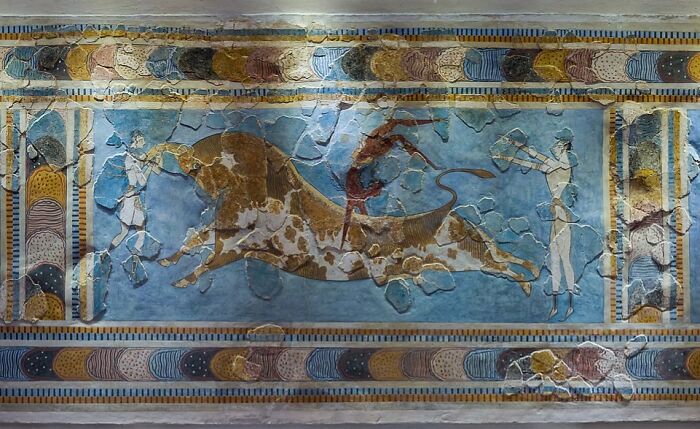
Image source: Heraklion Archaeological Museum, wikipedia.org
#4 Pankration From Ancient Greece
In ancient Greece, Pankration was the ultimate “no-holds-barred” combat sport, essentially a wild blend of boxing and wrestling introduced to the Olympic Games in 648 BC. Competitors could punch, kick, and use grappling holds like chokes and joint locks, with the only real rules being a strict ban on biting and eye-gouging. A match only ended when one fighter surrendered (often by raising a finger to signal defeat) was knocked unconscious, or in some extreme cases, lost their life in the process.

Image source: Daderot, wikipedia.org
#5 Fisherman Jousting Along The Nile River
Ancient Egyptian fishermen turned the Nile River into a competitive arena for a spontaneous and perilous game known as fisherman jousting. Two boats would approach each other, where the men would use their long punting poles as weapons to swipe at their rivals. The objective was simply to knock an opponent into the water, a victory that was especially dangerous since many of the fishermen never learned how to swim.
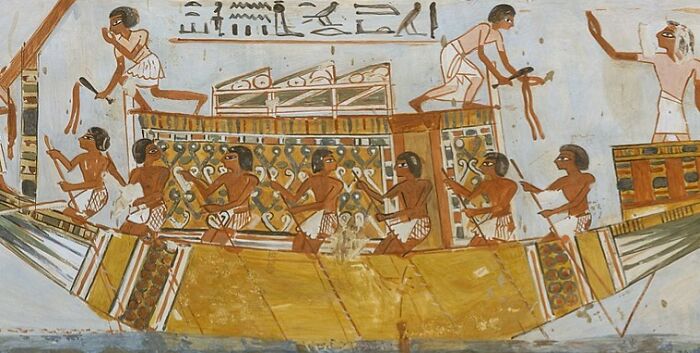
Image source: Charles Wilkinson, ancient-origins.net
#6 Gladiator Fights In Ancient Rome
Gladiator contests were the blockbuster entertainment of ancient Rome, pitting highly trained combatants, who were often slaves or prisoners, against each other in massive arenas. These weren’t just chaotic brawls; fighters specialized in distinct styles, such as the Retiarius with his net and trident or the heavily armed Secutor. Gladiators were expensive investments, and a crowd-pleasing performance could earn a defeated fighter mercy and the chance to fight another day.

Image source: Jean-Léon Gérôme, wikipedia.org
#7 Naumachia Was Played In Flooded Arenas
Ancient Rome’s idea of grand entertainment went far beyond the Colosseum with the creation of Naumachia, massive naval battles staged in flooded arenas. First organized on a spectacular scale by Julius Caesar, these events used thousands of prisoners of war as combatants and rowers aboard real warships. They would then fight, reenacting famous historical sea battles until one side’s fleet was completely sunk for the crowd’s amusement.

Image source: Lauro, Giacomo, wikipedia.org
#8 Viking Skin Pulling
The Vikings transformed the simple game of tug of war into a lethal contest with a version that used animal hides instead of a rope. This brutal test of strength was held over a large pit of fire. The objective was horrifyingly straightforward, as the losing team was not just defeated but was dragged directly into the flames.

Image source: Abbey of Saint-Aubin, wikipedia.org
#9 Camel Wrestling
Dating back over 2,400 years to nomadic Turkic tribes, camel wrestling is a traditional spectator sport still popular in the Aegean region of Turkey. The event pits two male Tulu camels against each other, typically during mating season when their natural instinct to fight for dominance is highest. The camels use their powerful necks to push and wrestle until one is forced to retreat or fall to the ground. Victory is declared not through injury but by submission, making it a test of strength and will rather than a fight to the finish.
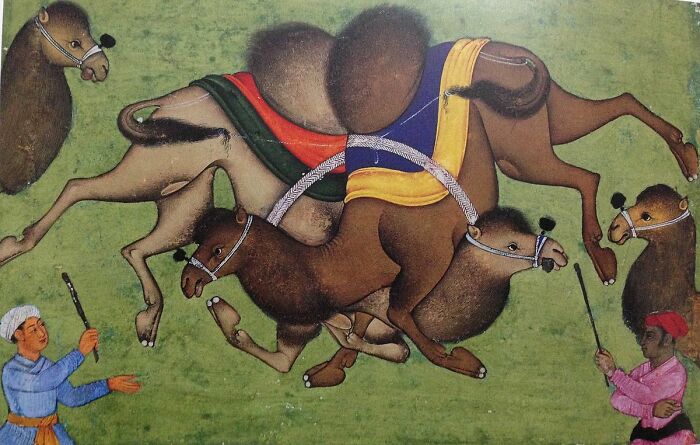
Image source: unknown, en.wikipedia.org
#10 Lion Hunt Of Ashurbanipal
In ancient Mesopotamia, lion hunting was less a sport and more a royal performance of power for Babylonian and Assyrian kings. This highly symbolic event was designed to showcase the ruler’s strength and his divine duty to protect civilization from the forces of chaos, which the lion represented. The hunts were often carefully orchestrated affairs where lions, captured beforehand, were released into a designated park or arena, allowing the king to slay them from a chariot or on foot in a grand public spectacle.
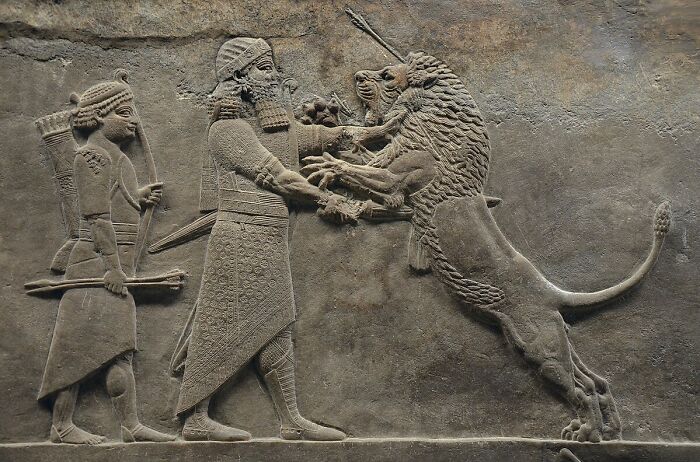
Image source: Carole Raddato, wikipedia.org
#11 Mongolian Wrestling
As one of Mongolia’s “Three Manly Arts,” the traditional wrestling style of Bökh is a pure test of strength where there are no weight classes, so a small competitor could be matched against a massive opponent. The goal is simple: force any part of your rival’s upper body, knee, or elbow to touch the ground. Clad in a distinct open-chested vest and briefs, wrestlers perform a ritual “eagle dance” before grappling in matches that have no time limits and end only when one man is brought down.
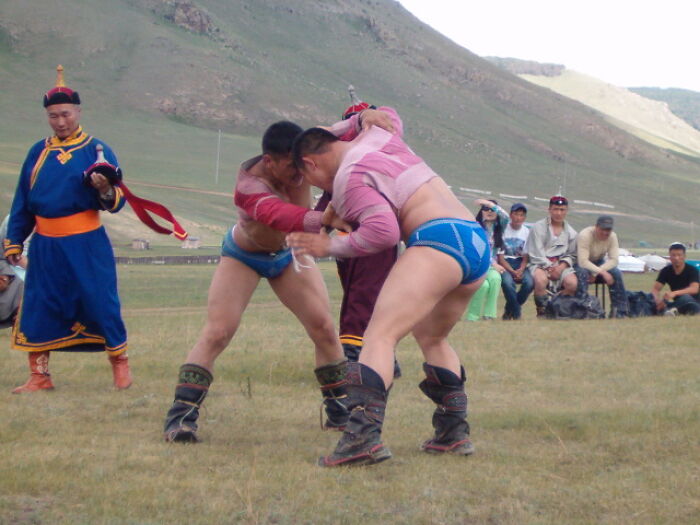
Image source: hu:Burumbátor, historycollection.com
#12 Cockfighting
With a history spanning thousands of years across multiple cultures, cockfighting turns natural rooster aggression into a brutal spectator event. The birds, specifically bred for their fighting instincts, are placed in a small ring known as a cockpit to battle. To ensure a more decisive and bloody outcome for gambling purposes, handlers often equip the roosters with sharp metal spurs, or gaffs, attached to their legs.

Image source: Thomas Rowlandson (1756–1827) and Augustus Charles Pugin (1762–1832) (after) John Bluck (fl. 1791–1819), Joseph Constantine Stadler (fl. 1780–1812), Thomas Sutherland (1785–1838), J. Hill, and Harraden (aquatint engravers), historycollection.com
#13 Pasola
What looks like a mounted battle with wooden spears is actually a celebratory festival called Pasola on the Indonesian island of Sumba. This event, rooted in a local legend about a heartbroken husband, is held to honor the start of the rice planting season. The ritual combat continues until blood is spilled, a necessary sacrifice believed to satisfy the ancestors and ensure a bountiful harvest. Although in ancient times losing one’s life in the game was considered a high honor, participants now use blunted spears, making the event far less dangerous.

Image source: Fakhri Anindita, historycollection.com
#14 Alligators Wrestling In Florida
Long before it became a roadside tourist spectacle, alligator wrestling was a cultural tradition for Florida’s Seminole people. This daring practice involved capturing the powerful reptiles with their bare hands, serving as both a tribal celebration and a way to secure food. The sport’s shift toward public entertainment reportedly began when a visitor on the Tamiami Trail paid a Seminole man for putting on a “great show,” demonstrating how the risky custom evolved into a performance.
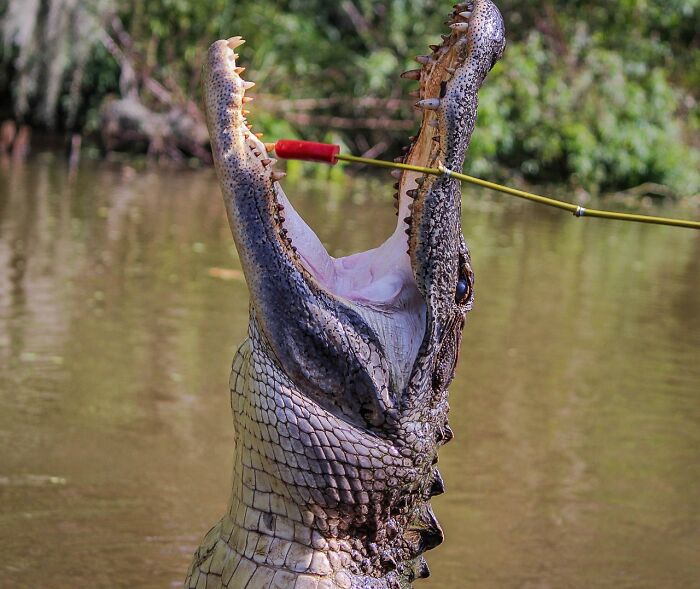
Image source: JamesDeMers, wikipedia.org
#15 Jousting
More than just a theatrical display for medieval nobility, jousting was a brutal sport with very real consequences, even for kings. In 1536, King Henry VIII was unhorsed and crushed by his own armored steed, leaving him with a festering leg wound and a suspected brain injury that may have triggered his infamous paranoia and tyranny. This wasn’t an isolated incident, as the “sport of kings” also proved fatal for King Henry II of France, who perished after a lance splinter pierced his eye during a tournament.
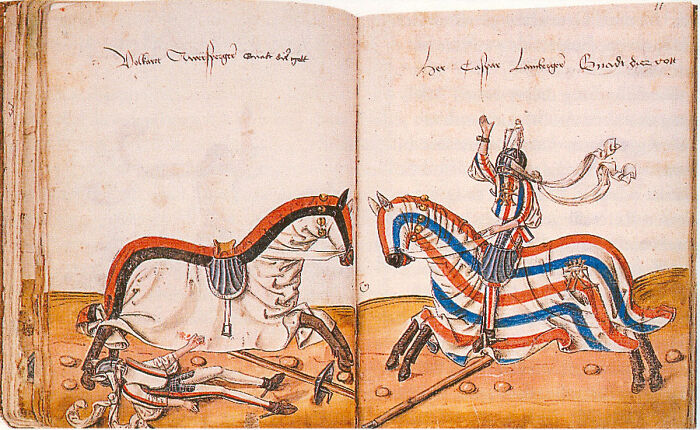
Image source: Unknown author, wikipedia.org
#16 Bridge Battles In Venice
The famous bridges of medieval Venice served as the battlegrounds for a uniquely brutal local tradition. Rival factions of working-class men would meet on a bridge and engage in a mass brawl with the sole purpose of throwing their opponents into the canal below. These stick-and-fist fights were so vicious, resulting in everything from knocked-out teeth to crippled legs, that they were proudly staged for visiting dignitaries. The spectacle prompted visiting French King Henry III to famously remark that it was “too small to be a real war and too cruel to be a game.”
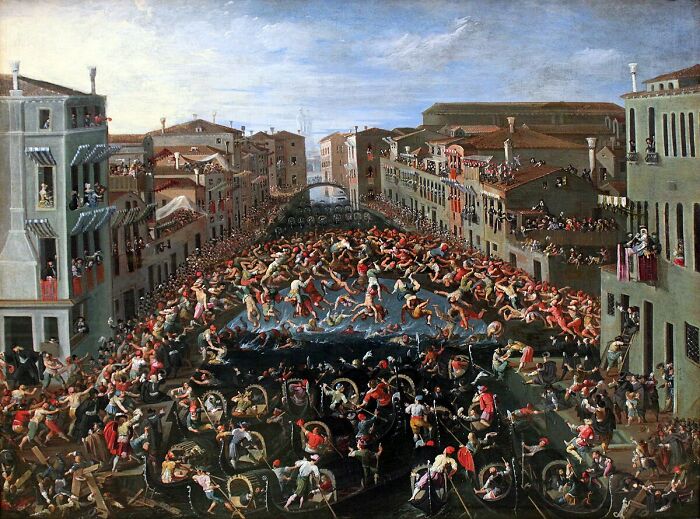
Image source: Joseph Heintz the Younger, wikipedia.org
#17 Tewaarathon Was An Extreme Lacrosse Game
Known among the Haudenosaunee people as the “Creator’s Game,” Tewaarathon was the original, sprawling ancestor of modern lacrosse. Vast teams, sometimes numbering in the hundreds or even thousands, would compete on fields that could stretch for several miles, with games lasting for days. More than just a sport, it was a sacred ritual used to settle tribal disputes and prepare young men for combat, earning it the nickname the “little brother of war” due to its intense and often violent nature.
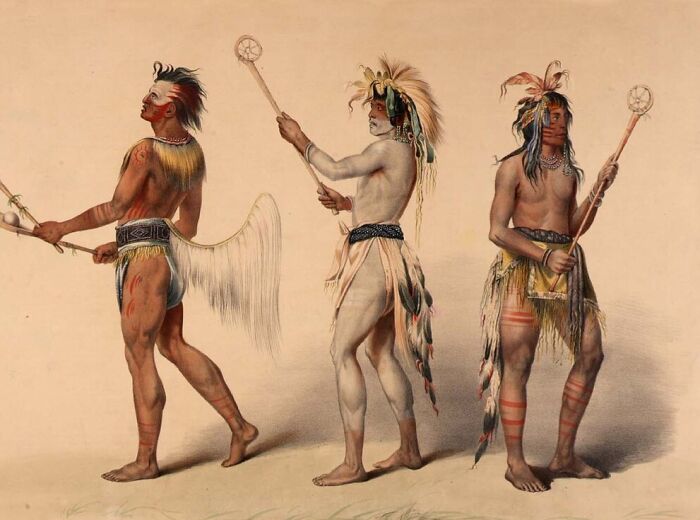
Image source: George Catlin, historicgeneva.org
#18 Buzkashi Is Polo But With A Goat Carcass
In Afghanistan, the national sport of buzkashi is an intense and chaotic version of polo where the ball is replaced with a goat carcass. Before the match, the animal is decapitated and its limbs are removed, creating a heavy and awkward prize for the horsemen to fight over. This game is a fierce free-for-all, with each rider battling to seize the carcass, break away from the pack, and drop it in a designated scoring circle.
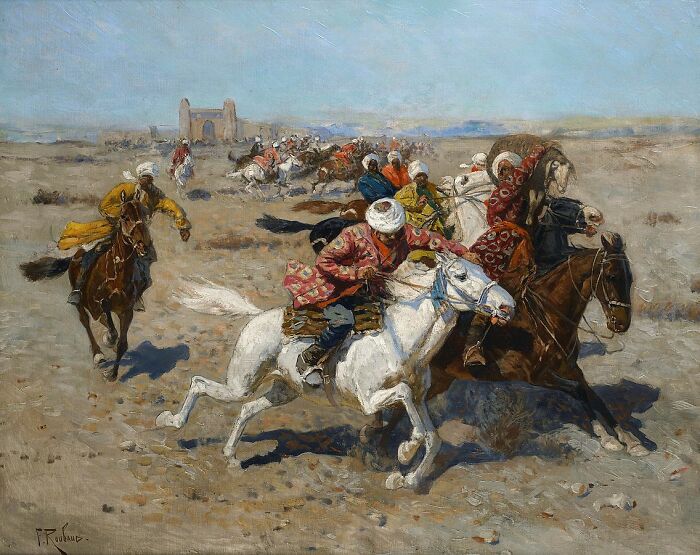
Image source: Franz Roubaud, wikipedia.org
#19 Venatio
Beyond the famous gladiator duels, Roman arenas were also home to the Venatio, a spectacular and brutal form of public entertainment. In these staged hunts, a vast array of exotic animals, sourced from the furthest corners of the empire like lions, bears, and even elephants, were pitted against armed hunters known as venatores. The event was less a fair contest and more a one sided slaughter, designed to showcase Rome’s dominion over the natural world and entertain the masses with bloody carnage.

Image source: Studio artist of Firmin Didot, wikipedia.org
#20 Medieval Tournament Melee
Forget the one-on-one chivalry of jousting; the medieval melee tournament was a full-blown team brawl where two sides of armored knights clashed in a chaotic free-for-all. The primary objective was not necessarily to take a life but to capture opponents who could then be held for a profitable ransom. Even with blunted weapons, the sheer violence of the scrum meant that serious injuries and casualties were common, making it a lucrative yet perilous form of military training disguised as a sport.

Image source: Unknown author, wikipedia.org
#21 Fox Tossing
A bizarre pastime popular among European aristocrats in the 17th and 18th centuries, fox tossing was a cruel form of entertainment staged in large courtyards. Teams of two people would hold a long fabric sling, and when a fox was released into the arena and ran across the sling, they would pull it taut to launch the animal high into the air. The goal was simply to achieve the greatest height, a spectacle that typically resulted in a fatal landing for the fox.

Image source: Johann Friedrich von Flemming, wikipedia.org
#22 Bare-Knuckle Boxing
Before padded gloves and timed rounds, bare-knuckle boxing reigned as a raw and grueling test of endurance. Popularized in 18th-century England, a round didn’t end until a fighter was knocked to the ground, after which he had a short window to recover and continue. This unique rule set meant matches were often marathons of attrition, with some legendary bouts lasting for hours and stretching over 70 rounds, ending only when one man could no longer stand.

Image source: George Cruickshank, wikipedia.org
#23 Dog Fighting
Rooted in illegal gambling, dog fighting is a brutal blood sport where two dogs, specifically bred and trained for aggression, are forced to battle in an enclosed pit. The animals are conditioned to fight relentlessly, often until one is severely maimed or finished off.

Image source: Azim Azimzade, wikipedia.org
#24 The Early Form Of Savate
Before it evolved into the elegant sport of French kickboxing, the early form of Savate was a gritty street-fighting method developed in the back alleys of 19th-century Paris. Its name literally means “old shoe,” a nod to its most important feature: using the heavy footwear of the day to deliver brutal, low kicks. The hands were used almost exclusively for defense or open-handed slaps, as the system was designed for self-preservation, not a regulated match.
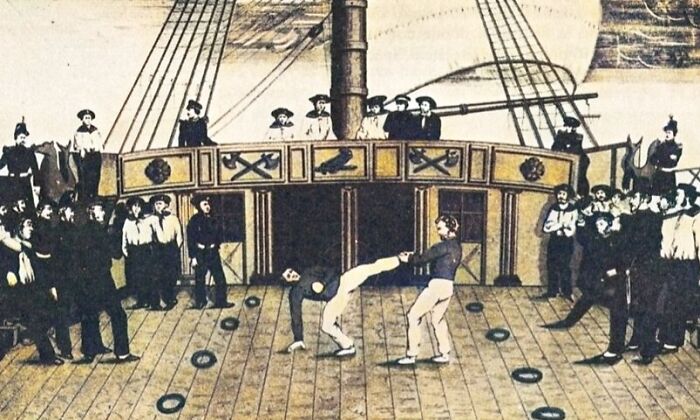
Image source: Théophile Gautier , wikipedia.org
#25 Florentine Calcio Storico
A brutal mix of soccer, rugby, and bare-knuckle brawling, Florentine Calcio Storico is a historical sport still played today in Florence, Italy. Two teams of 27 players, clad in historical attire, face off on a sand-covered square with the simple goal of getting a ball into the opposing net. To achieve this, nearly any tactic is permitted, including punching, kicking, and wrestling, making the annual event a famously chaotic and punishing spectacle of civic pride.
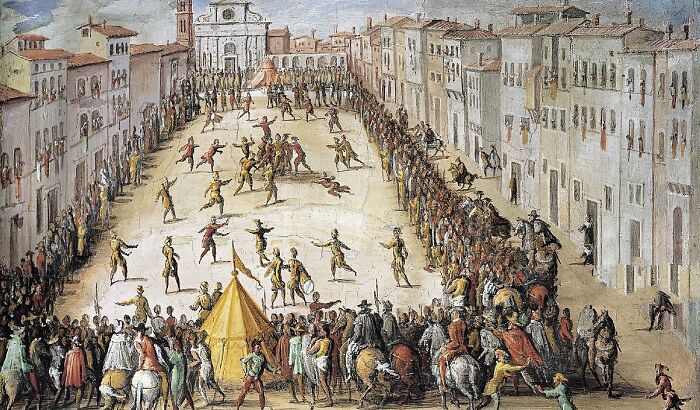
Image source: Stradanus, wikipedia.org
#26 Pelota Mixteca From Mexico
Originating from the Zapotec and Mixtec cultures of Oaxaca, Mexico, Pelota Mixteca is a high-impact ball game played with a massive, decorated glove. Players use these heavy, studded gloves, which can weigh over 10 pounds, to strike a solid rubber ball back and forth across a long, rectangular court. Similar to a netless version of tennis, the objective is to land the ball in the opposing team’s territory where it cannot be returned.

Image source: Scott Kraft, wikipedia.org
#27 Cooper’s Hill Cheese-Rolling And Wake
Every year in Gloucestershire, England, hundreds of competitors gather at the top of the treacherously steep Cooper’s Hill for the annual Cheese Rolling event. A nine-pound wheel of Double Gloucester cheese is sent tumbling down the slope, and the participants then hurl themselves down after it in a chaotic free-for-all. The first person to reach the bottom of the hill wins the cheese, though victory almost always involves an uncontrolled tumble and a significant risk of sprains, fractures, and other injuries.

Image source: Dave Farrance, wikipedia.org
#28 Celtic Head-Hunting Games
For ancient Celtic warriors, the ultimate competitive trophy was not a medal, but the severed head of a vanquished enemy. This gruesome practice was rooted in the belief that the head contained the soul, so capturing one was a way to seize an opponent’s spirit and power. These macabre prizes were often preserved, sometimes with cedar oil, and proudly displayed on saddles or over doorways as a direct measure of a warrior’s prowess and status.
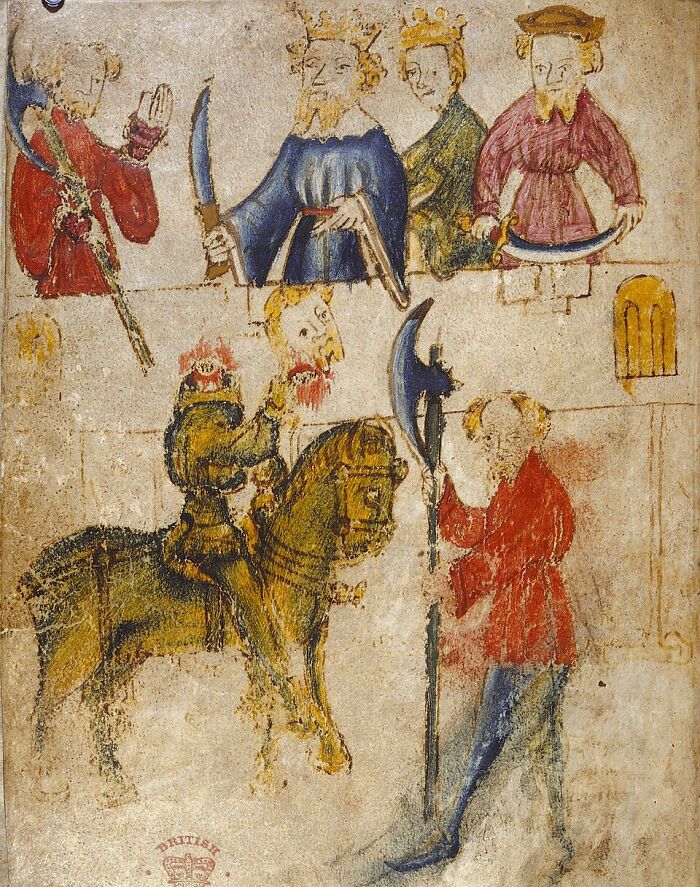
Image source: unknown author, wikipedia.org
#29 Yabusame
Combining incredible equestrian skill with pinpoint archery, Yabusame is a traditional Japanese ritual where an archer on a galloping horse attempts to shoot three wooden targets. Dating back to the samurai era, this highly disciplined art is more of a religious ceremony performed at Shinto shrines than a competitive sport. The archer uses special turnip-shaped arrows that are designed to whistle as they fly, and successfully hitting all three targets is considered a great honor and a sign of divine favor.
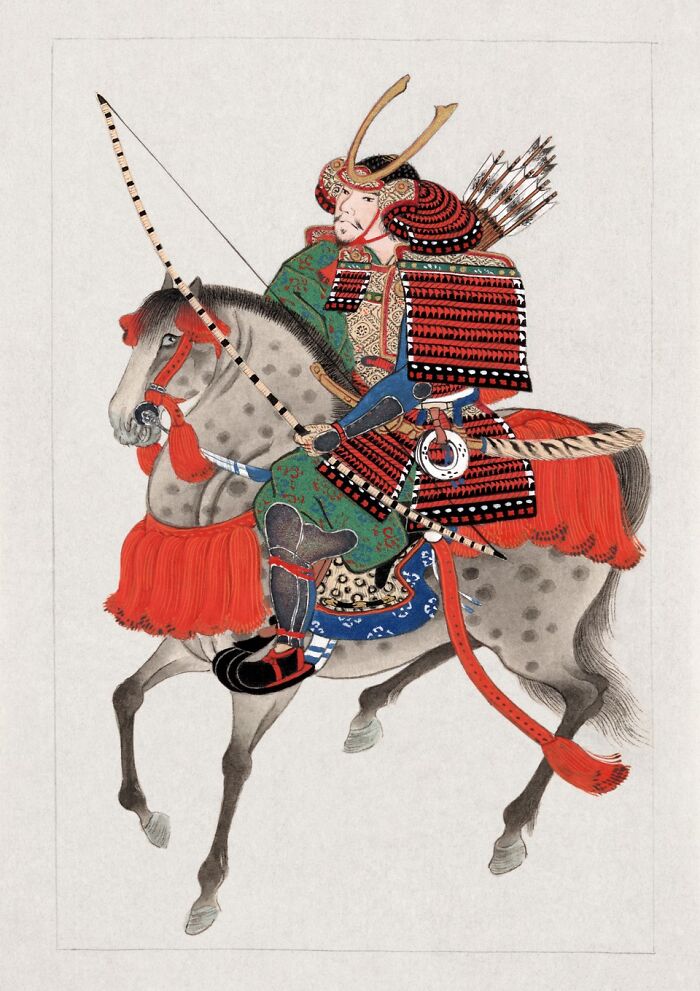
Image source: unknown author, wikipedia.org
#30 Shin Kicking From Ancient England
The English sport of shin kicking is a straightforward and brutal contest of pain tolerance with rules that are exactly what the name implies. Two competitors face each other, grab hold of their opponent’s collar, and then proceed to kick each other squarely in the shins. While competitors traditionally stuff their trousers with straw for a bit of padding, the match only ends when one person gives up from the sheer agony.
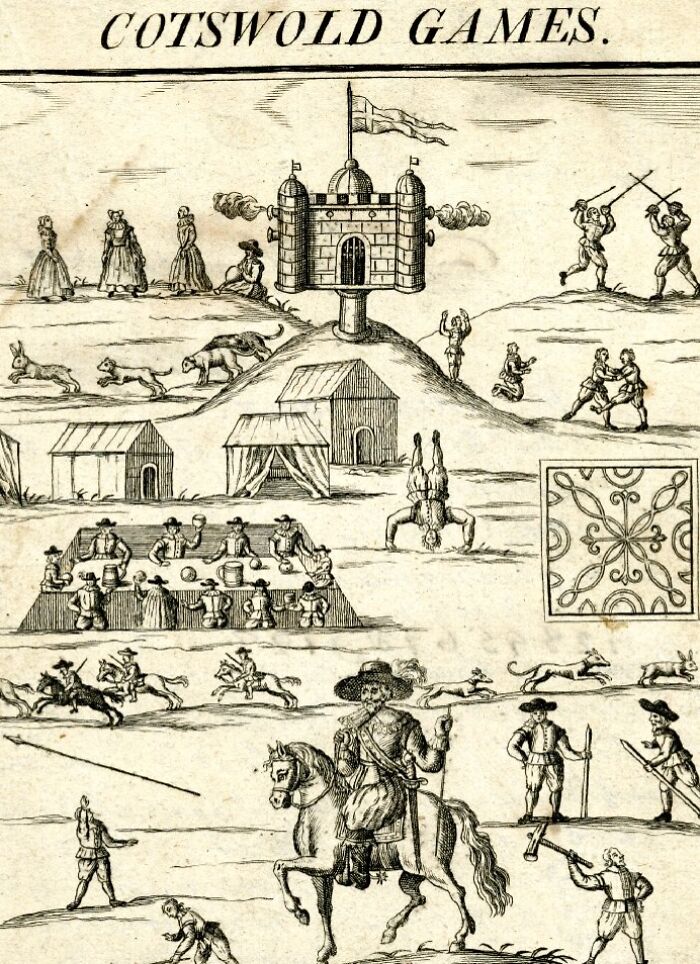
Image source: Unknown author, historycollection.com
#31 Bullfighting
More than just a simple contest, traditional Spanish bullfighting is a highly ritualized performance divided into three distinct stages, or “tercios.” In the final stage, the matador uses a small red cape, the muleta, to execute a series of artistic passes, demonstrating control and grace before attempting to dispatch the bull with a single sword thrust. A skilled performance and a clean end of the animal are rewarded by the crowd, who may petition the event’s president to award the matador trophies, traditionally one or both of the bull’s ears, as a sign of a triumphant display.
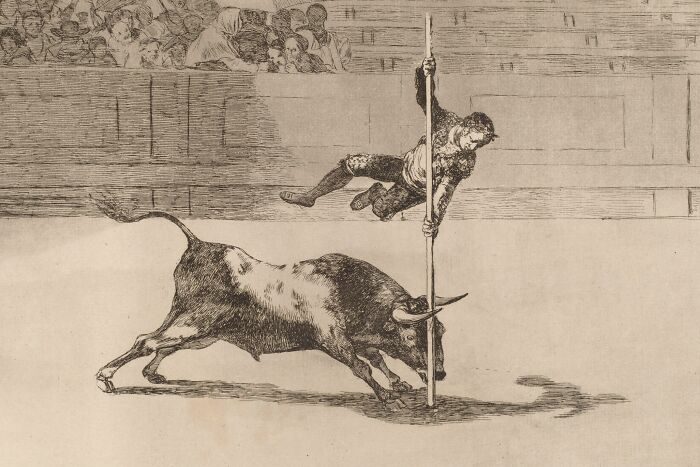
Image source: Francisco Goya (1746–1828), historycollection.com
#32 Roman Chariot Racing Was Every Bit As Intense As ‘Ben-Hur’ Portrayed
As the premier spectator sport of the Roman Empire, chariot racing was a high-speed spectacle held in massive arenas like the Circus Maximus, where superstar drivers competed for one of four professional factions: the Reds, Whites, Blues, or Greens. These races were incredibly dangerous, involving several laps around a track at top speed, with drivers wrapping the reins around their torsos for better control of their four-horse teams. This high-risk tactic meant that spectacular and often fatal crashes were common, forcing charioteers to carry a knife to cut themselves free before being dragged to their peril.
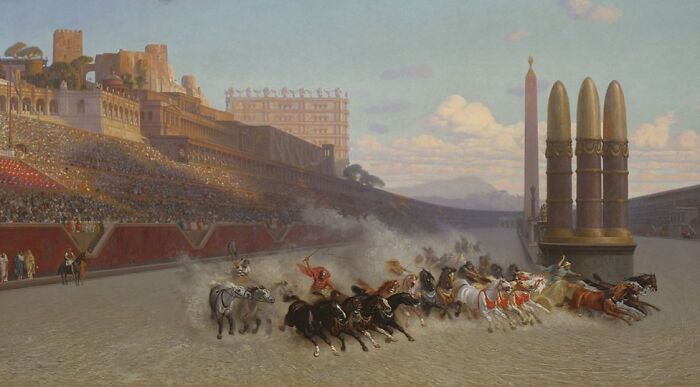
Image source: Jean-Léon Gérôme, wikipedia.org
#33 Spartan Krypteia Played By Teenagers
The culmination of a brutal Spartan upbringing was the Krypteia, a final test that functioned as a state-sanctioned terror mission. As their final trial, select young men were sent into the countryside armed only with a dagger, tasked with secretly hunting and executing members of the helot population, Sparta’s state-owned slaves. This gruesome rite of passage served a dual purpose: it was the ultimate test of a young warrior’s stealth and ruthlessness while also acting as a calculated campaign of fear to control the vastly larger slave population.
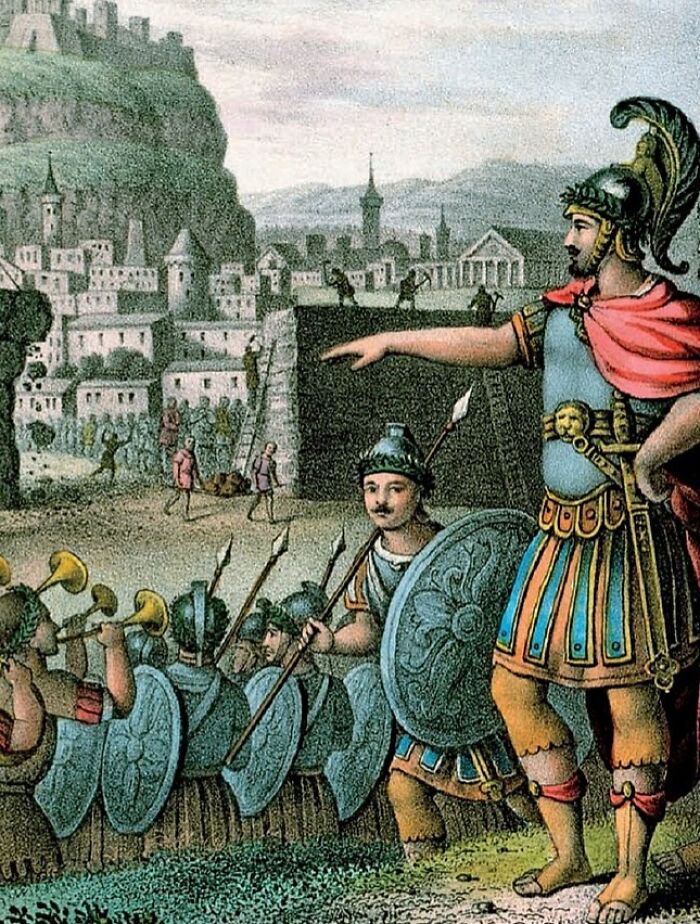
Image source: unknown author, wikipedia.org
#34 Hōlua Sledding Down The Sides Of Volcanoes
For ancient Hawaiian royalty, the ultimate extreme sport was hōlua, a form of high-speed sledding down the steep slopes of volcanoes. Competitors would ride headfirst on narrow wooden sleds, called papa hālua, down specially prepared tracks of rock and earth that could stretch for thousands of feet. More than just a dangerous competition between chiefs to display their courage, the sport was also considered a sacred practice with deep spiritual significance.
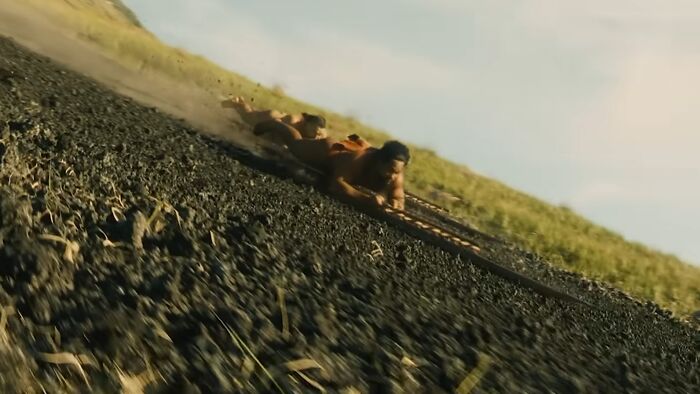
Image source: apple.com, wikipedia.org
#35 Viking Holmgang
When Vikings had an unresolvable dispute over honor or property, they could settle it through a Holmgang, a legally sanctioned duel. The combatants would fight on a small island or a designated hide laid on the ground, an area which they could not leave. Governed by a strict set of rules, the duel continued until one person lost their life, yielded, or sometimes just drew first blood, with the victor automatically winning the original argument in the eyes of the law.
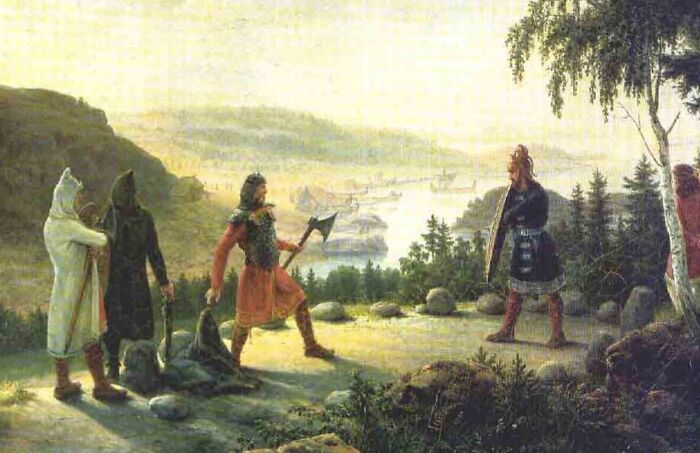
Image source: Johannes Flintoe , wikipedia.org
#36 Bo-Taoshi From Japan
A chaotic spectacle played by cadets at Japan’s National Defense Academy, Bo-taoshi is essentially a 300-person battle to topple a giant wooden pole. Each team of 150 is divided into attackers and defenders, with the defense forming a dense human scrum at the pole’s base while a single “ninja” balances on top. The attackers must then storm this fortress, climbing over their opponents in a frantic effort to pull the pole down to a thirty-degree angle for the win.

Image source: Abasaa, wikipedia.org
#37 Chovgan From Ancient Persia
The ancestor of modern polo, Chovgan, was a fast-paced and aristocratic game played in ancient Persia and Azerbaijan. Riders would charge across a field, using long wooden mallets to strike a ball through the opponent’s goalposts. More than just a competition, it served as essential training for elite cavalry units and was a major social spectacle for nobles. Often accompanied by traditional music, the sport was a complete cultural event, blending athletic skill with artistic performance.
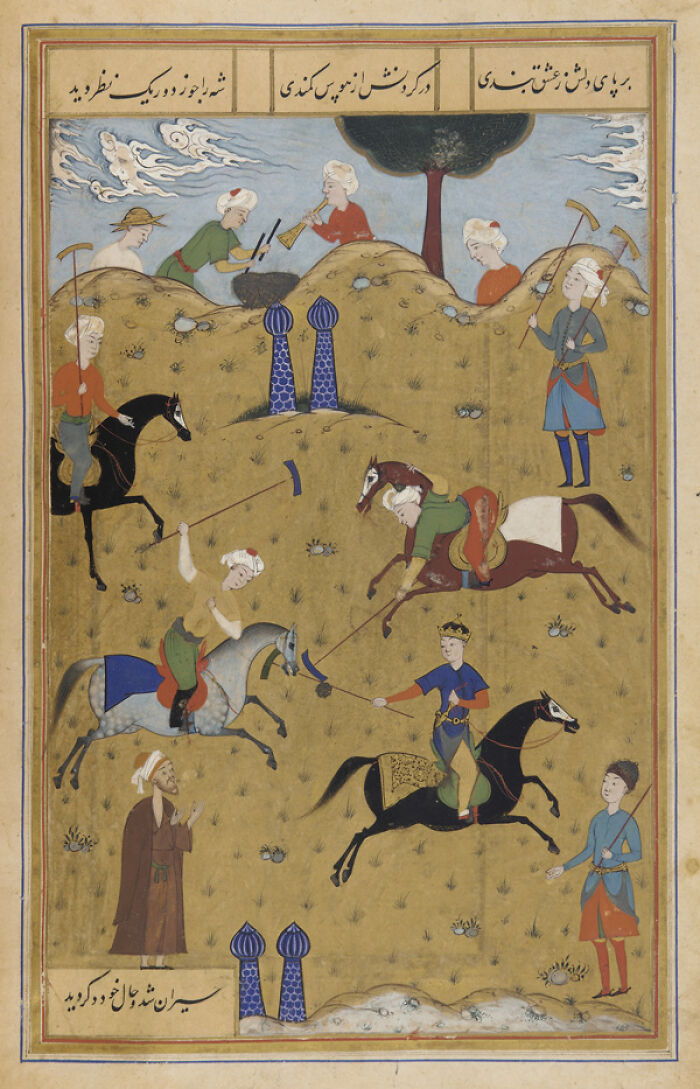
Image source: Shah Mahmud Nishapuri , wikipedia.org
#38 Tchung-Kee A.K.A. Chunkey
The Native American game of Chunkey was a contest of precision and anticipation played on long, smoothed clay courts. One player would roll a polished, disc-shaped stone, and as it traveled, other competitors would throw their spears to predict where the stone would finally come to rest. While the game itself was far less violent than many ancient sports, the real danger lay in the high-stakes gambling that surrounded it, as it was common for players to wager all of their possessions on the outcome of a single throw.

Image source: George Catlin (1796–1872) , historycollection.com
#39 Anastenaria
Anastenaria is a religious ritual practiced in parts of Greece and Bulgaria where participants walk barefoot across hot embers while carrying the icons of Saints Constantine and Athanasius. Adherents believe a state of spiritual ecstasy, granted by the saints, protects them from being burned. While the tradition is explained by a Christian legend about rescuing the icons from a church fire, its origins are often linked by scholars to ancient pagan firewalking rituals, possibly connected to the worship of Dionysus.
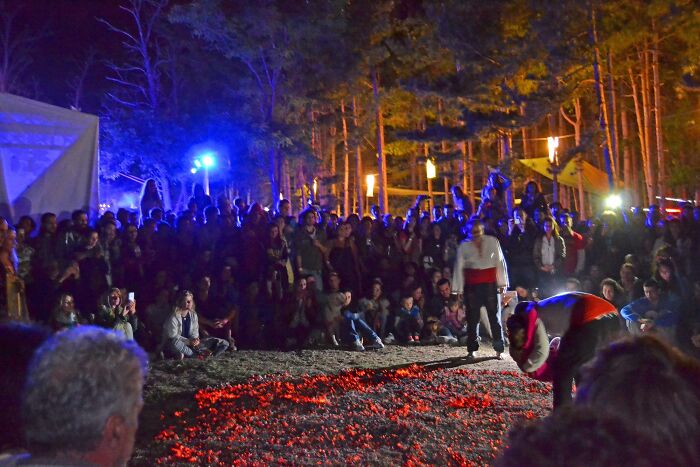
Image source: Zigzag0858, listverse.com
#40 Stick Fighting
As one of the world’s most ancient and widespread martial arts, stick fighting appears in countless cultural forms, ranging from folk dance to brutal combat. In Egypt, the stylized art of Tahtib involves long staffs in a performance that emphasizes skill and grace. This contrasts sharply with the Donga stick fighting of Ethiopia’s Suri people, a violent rite of passage where men engage in fierce duels to prove their manhood and win wives.
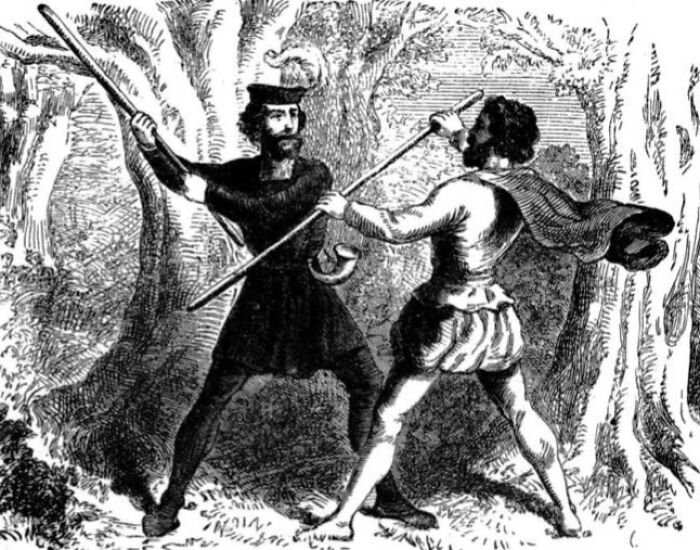
Image source: unknown author, wikipedia.org
#41 Knattleikr From Viking Times
The Vikings had their own version of a rugged ball game known as Knattleikr, played with a hard ball and a bat, often on frozen fields or ice. With very few rules, the game was notoriously brutal, allowing players to tackle, wrestle, and physically overpower opponents to gain control of the ball. These day-long matches were as much a test of endurance and combat readiness as they were a sport, and it wasn’t uncommon for heated on-field disputes to escalate into serious real-world feuds.
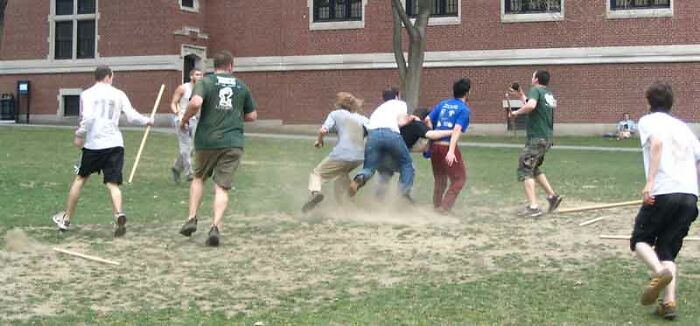
Image source: David Pugh, listverse.com
 Follow Us
Follow Us





